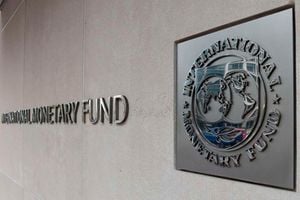International Monetary Fund headquarters building in Washington, DC.
"Heavy handed and intrusive.” This is the picture that emerges from a closer look at the International Monetary Fund conditions which the government is being forced to implement at the electricity utility, Kenya Power.
First, by the end of December 2024, it should settle a Sh19.4 billion debt owed to the Rural Electricity Authority.
Second, by the end of December, it should have dissolved the board and introduced a new governance structure to give private shareholders fair representation.
Third, by the end of December, it should have transferred all the transmission assets to the Kenya Electricity Transmission Company Limited (Ketraco).
Fourth, it should reduce system losses from the current 22.4 per cent to 14.4 per cent by the end of June 2025.
Fifth, the system losses be broken down into reduction of five per cent on commercial losses, two per cent on technical losses and one per cent on transmission losses.
Sixth, KPLC and the Renewable Energy Corporation should enter into a commercial contract stipulating coverage of the corporation’s maintenance and operations costs.
The details of these conditions are contained in an appendix to a “letter of intent” by the National Treasury to the IMF.
Whether the government will deliver on such a wide range and number of conditions within such a short time frame remains to be seen.
But the most politically unpopular will be the conditioning of dissolving the board of KPLC and replacing them with professionals nominated on the basis of skills and experience.
The board of the utility is mainly populated by cronies of powerful politicians who will be inclined to oppose the idea of a board that reflects the shareholding structure of the company.
The new corporate governance being proposed may also eliminate the representation by the so called ex-officio members – fellows appointed by the Cabinet Secretary to represent the Ministry of Energy and the actual shareholder, the National Treasury.
When adopted, directors’ elections in listed companies will contribute to corporate democracy and make them more meaningful.
During the company’s Annual General Meeting (AGM) in December 2022, the government removed almost all independent directors, replacing them with individuals with obvious links to the ruling party.
Directors were not elected for their qualifications and skills but because minority shareholders had no say on the matter.
The handful of shareholders who attended were a passive lot. There was a time when the practice was that half of the directors would be on rotation and offer themselves for re-election while the remaining would not have to be subjected to a vote.
In that instance, Finance Cabinet Secretary Njuguna Ndung’u, who represents the majority shareholder, the government, wielded the powers to single-handedly remove all directors. Weeks before the AGM, he sealed the fate of most of the directors by giving notice to the Company Secretary, informing her that he would be making a resolution to remove most of the directors, including the chair, Ms Vivian Yeda, who was not rotating this time around.
Mr Yida Kemoli, who was appointed to the board in December last year, was not due for rotation. Kenya Power directors’ elections had been rendered into rituals that were largely a formality. Attendance of AGMs had over the years dropped markedly.
In the past, Kenya Power AGMs used to attract attendance activist shareholders who would ask tough questions and heckle the directors. Today, the shareholder attends an AGM to be given branded t-shirts, hats, and umbrellas.
Under the new IMF conditions, the private sector, the holder of Class A shares, will be entitled to appoint four directors, while the government – holder of Class B shares, will be entitled to appoint five – including the chairman.
Whether it will happen remains to be seen because crafty elites – who have to make sure that their cronies are appointed to boards – have in the past come up with schemes to go around such rules.
In boards of state agencies – where laws and regulations provided and ring-fenced board seats to specific stakeholders and interest groups such as the Federation of Kenyan Employers, the Central Organisation of Trade Unions, or the Institute of Certified Public Accountants of Kenya – corrupt elites just manoeuvred to make sure that their cronies were the ones nominated to represent such private sector entities to the boards.
It would appear that the designers of the IMF conditions saw the loophole, which is why they have provided that KPLC’s independent directors be nominated through a transparent process involving private and independent consultants.










